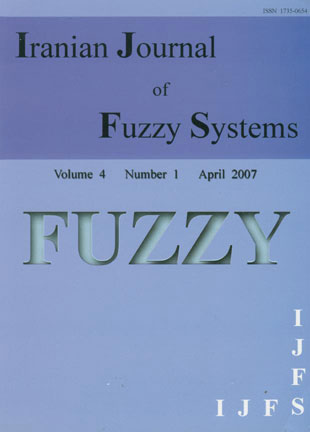فهرست مطالب

Iranian journal of fuzzy systems
Volume:4 Issue: 1, 2007
- تاریخ انتشار: 1386/05/11
- تعداد عناوین: 7
-
-
Page 1In this study, we introduce and study a concept of distributed fuzzy modeling. Fuzzy modeling encountered so far is predominantly of a centralized nature by being focused on the use of a single data set. In contrast to this style of modeling, the proposed paradigm of distributed and collaborative modeling is concerned with distributed models which are constructed in a highly collaborative fashion. In a nutshell, distributed models reconcile and aggregate findings of the individual fuzzy models produced on a basis of local data sets. The individual models are formed in a highly synergistic, collaborative manner. Given the fact that fuzzy models are inherently granular constructs that dwell upon collections of information granules – fuzzy sets, this observation implies a certain general development process. There are two fundamental design issues of this style of modeling, namely (a) a formation of information granules carried out on a basis of locally available data and their collaborative refinement, and (b) construction of local models with the use of properly established collaborative linkages. We discuss the underlying general concepts and then elaborate on their detailed development. Information granulation is realized in terms of fuzzy clustering. Local models emerge in the form of rule-based systems. The paper elaborates on a number of mechanisms of collaboration offering two general categories of so-called horizontal and vertical clustering. The study also addresses an issue of collaboration in cases when such interaction involves information granules formed at different levels of specificity (granularity). It is shown how various algorithms of collaboration lead to the emergence of fuzzy models involving information granules of higher type such as e.g., type-2 fuzzy sets.
-
Page 22This paper considers the automatic design of fuzzy rule-based classification systems based on labeled data. The classification performance and interpretability are of major importance in these systems. In this paper, we utilize the distribution of training patterns in decision subspace of each fuzzy rule to improve its initially assigned certainty grade (i.e. rule weight). Our approach uses a punishment algorithm to reduce the decision subspace of a rule by reducing its weight, such that its performance is enhanced. Obviously, this reduction will cause the decision subspace of adjacent overlapping rules to be increased and consequently rewarding these rules. The results of computer simulations on some well-known data sets show the effectiveness of our approach.
-
Page 37Prompt detection and diagnosis of faults in industrial systems are essential to minimize the production losses, increase the safety of the operator and the equipment. Several techniques are available in the literature to achieve these objectives. This paper presents fuzzy based control and fault detection for a 6/4 switched reluctance motor. The fuzzy logic control performs like a classical proportional plus integral controller, giving the current reference variation based on speed error and its change. Also, the fuzzy inference system is created and rule base are evaluated relating the parameters to the type of the faults. These rules are fired for specific changes in system parameters and the faults are diagnosed. The feasibility of fuzzy based fault diagnosis and control scheme is demonstrated by applying it to simulated system.
-
Page 53In this paper we define intuitionistic fuzzy metric and normed spaces. We first consider finite dimensional intuitionistic fuzzy normed spaces and prove several theorems about completeness, compactness and weak convergence in these spaces. In section 3 we define the intuitionistic fuzzy quotient norm and study completeness and review some fundamental theorems. Finally, we consider some properties of approximation theory in intuitionistic fuzzy metric spaces.
-
Page 65The purpose of this paper is to introduce the concept of L-fuzzy bilinear operators, we obtain a decomposition theorem for L-fuzzy bilinear operator. Then we prove that L-fuzzy bilinear operator is the same as powerset operator for variable-basis introduced by S.E.Rodabaugh (1991). Finally we discuss the continuity of L-fuzzy bilinear operators.
-
Page 68In this paper, some elementary operations on triangular fuzzy numbers (TFNs) are defined. Like classical matrices we also define some operations on triangular fuzzy matrices (TFMs). Here we define trace of TFMs and triangular fuzzy determinant (TFD). Using the elementary operations, some important properties of TFMs are presented. The concept of adjoint on TFM is discussed and also presented some properties of it. Some special types of TFMs i.e., pure and fuzzy triangular, symmetric, pure and fuzzy skewsymmetric, singular, semi-singular, constant etc. TFMs are defined here. A number of properties on these TFMs are presented in this paper.
-
Page 89The object of this paper is to introduce the notion of intuitionistic fuzzy continuous mappings and intuitionistic fuzzy bounded linear operators from one intuitionistic fuzzy n-normed linear space to another. Relation between intuitionistic fuzzy continuity and intuitionistic fuzzy bounded linear operators are studied and some interesting results are obtained.

